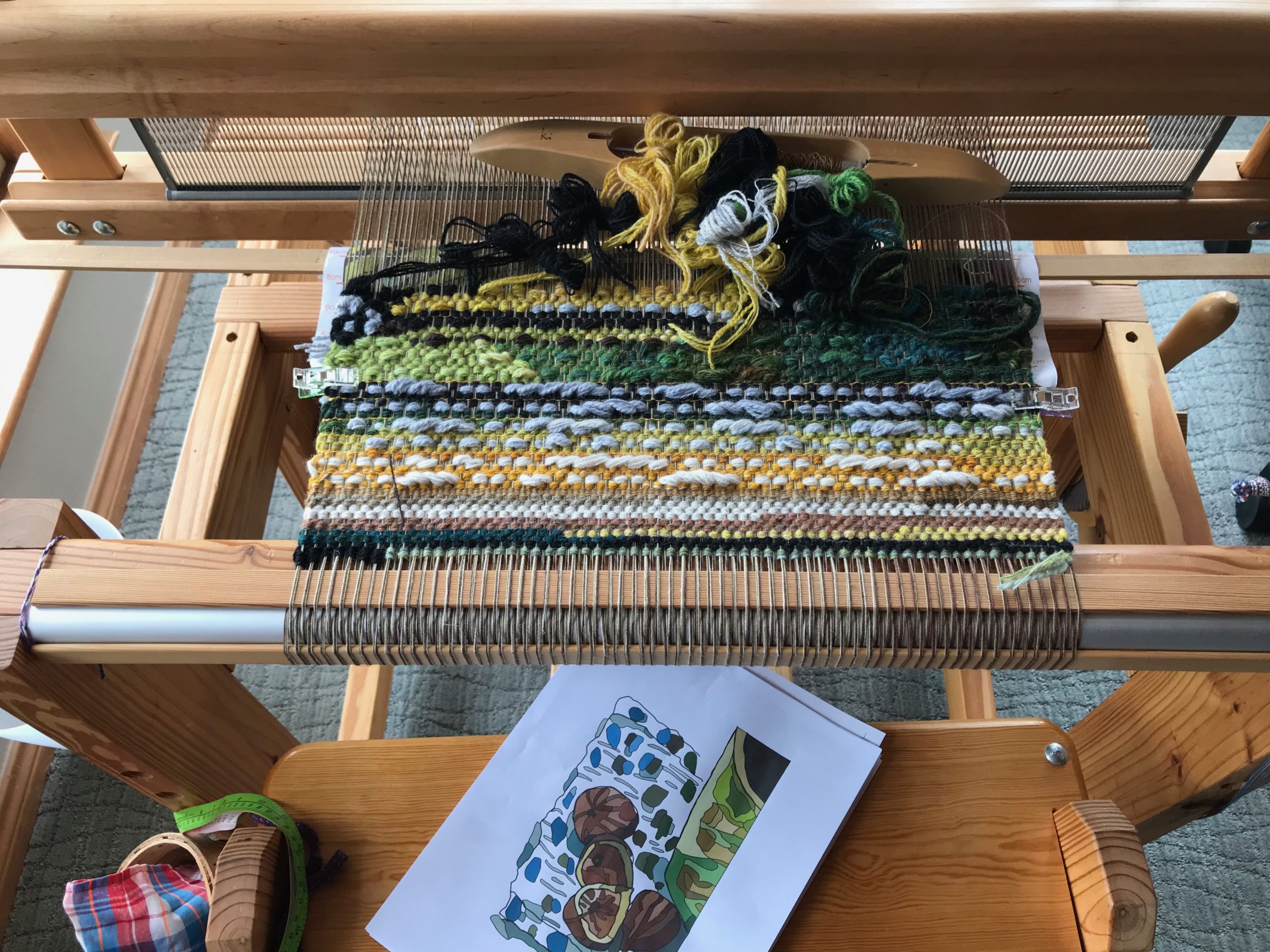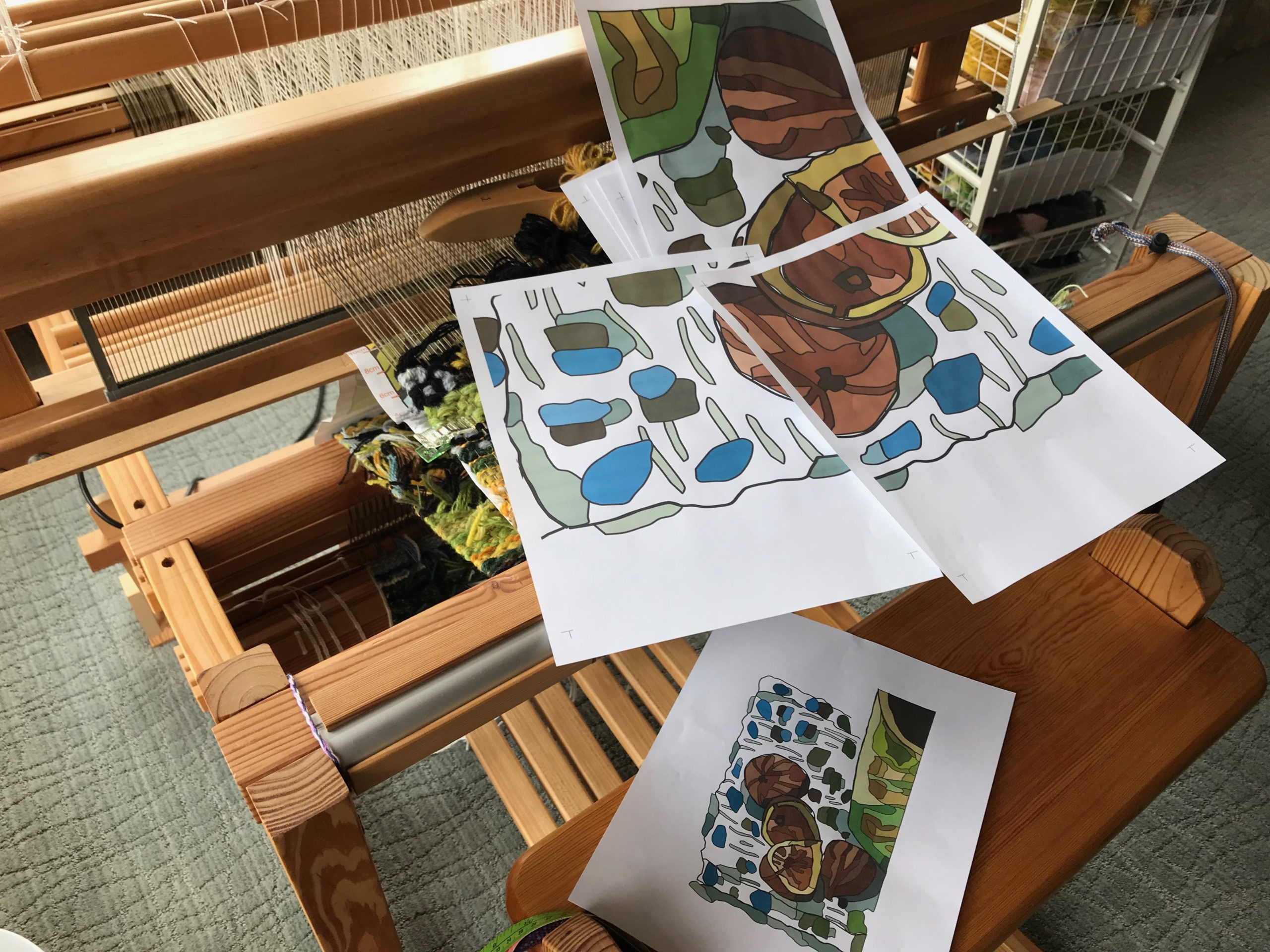I started this warp as a place to test some tapestry techniques. I have studied, practiced, and evaluated my own results from techniques used by various tapestry artists. What I have learned is that I prefer the techniques that I am already familiar with, that I learned from my friend Joanne Hall. I am ready to dive in one more time on this warp to refine my own approach to pictorial tapestry weaving.

This little hand-built loom has been sitting idle long enough. It’s time to start again. Starting takes courage. The cartoon is almost ready. Soon, this little loom will be back in action as my favorite place to be immersed in color and yarn.

May you start as soon as you can.
Happy Weaving,
Karen

This is a perfect little loom for your tapestries.
And I love your sampling.
I see in your first photo that you are having fun exploring these techniques and the results are so very interesting. I see the soumak and you do it so well. It is so engaging to be immersed in a design.
I have given some thought to doing more tapestry as soon as my schedule will allow. I taught a tapestry class at our conference in June and now for our guild, which makes me want to get back to having some fun like I see you are doing.
Joanne
Hi Joanne, This little loom suits me very well for this type of weaving. It’s true I have had fun sampling different techniques. I am really itching to get this last sample going because I enjoy this tapestry process so much, and I have missed it.
Oh, I do hope you do some more tapestry soon. I said to Steve just yesterday that “I hope Joanne does more tapestry. I would love to see what tapestry she weaves next.” 🙂 Maybe you’ll make my dreams come true. I know you will truly enjoy getting your hands in these wool yarn colors.
Karen
Fresh Figs???
I gorge on dried figs. When I can find them.
I discovered a tapestry weaving I did in high school. On a small frame made from a piece of corrugated cardboard box. The only boundaries I knew were the ones presented by the corrugated cardboard and yarn scraps from the attic storage.
It impressed me by how it rivals my current work, 45 years later. Youth doesn’t recognize boundaries that I trip over now.
May God bless your mind and your hands.
Hi Nannette, The fig tree (Brown Turkey figs) in our backyard surprised us with an overabundant harvest this summer. I have enough in the freezer to make a batch of fig preserves soon.
I have some tapestry examples, too, from much younger days, before I knew much of anything about weaving. What it tells me is that, even way back then, I was drawn to the intriguing possibilities and results of tapestry weaving.
Thanks for your thoughtful comments.
Karen
The little loom you are referring to is, what loom? Wondering if it is a Julia four shaft.I was a member of Joanne Halls class this summer in Montana. I do not have a tapestry loom, but would like to find a loom that is multi-purpose like I imagine the Julia could be.
Hi Julienne, I’m so glad you got to take Joanne Hall’s class! The little loom I’m referring to here is a loom that was handbuilt by my husband. It is similar in size to the Glimåkra Julia loom (which I have, as well). The Julia would be as perfect for small pictorial tapestries as my little loom is. Four shafts and six treadles (four treadles for rosepath, and two treadles for plain weave) is all that is needed. The Julia (mine is 8 shafts) can weave anything I can think up – from fine linens to small rugs to tapestry. I like the loom a lot!
Thanks for asking,
Karen
I am really intrigued by this style of tapestry weaving where the warp threads are showing rather than being completely covered. Is there a name for this style? Where can I find more information on it?
Thank you,
Jean
Hi Jean, I don’t know if there is an official name for this style. I know of only a very few tapestry weavers that weave in this style. Joanne Hall calls it pictorial tapestry, so that’s what I like to call it.
Another tapestry artist with a similar style is Helena Hernmarck, who has many very large tapestries, many with an emphasis on realism. You can find some of her works through an internet search.
The best thing you can do to learn this technique is to take a pictorial tapestry class or workshop from Joanne. Prior to taking her class, though, immerse yourself in traditional tapestry techniques, such as meet and separate, and color value studies. You really need that traditional tapestry foundation to build on for this pictorial tapestry style. Some really good books I have used for tapestry study: “Tapestry Weaving,” by Kirsten Glasbrook, and “The Art of Tapestry Weaving,” by Rebecca Mezoff.
I hope this gives you some good leads.
Karen
Thanks Karen. I have done traditional tapestry, and I have the Glasbrook book, also Lisa Trujillo’s “A Chimayo Weaver’s Guidebook” for that particular style. I just really like the looks of the warp showing, and had never seen it much. I can’t tell from the photos what threading you use, just a plain weave or some kind of simple twill like rosepath. I have a non-weaving book, “Wayfaring Strangers: The Musical Voyage from Scotland and Ulster to Appalachia” which has a few photos of tapestries with warp showing. They are credited to Barbara Grinnell. This made me wonder if this style originated as a regional style in the Appalachias. Anyway, thanks for the information. I will investigate the two weavers you mentioned and of course keep watching your progress!
Hi Jean, How interesting that you have noticed tapestries with warp showing in the book about Appalachia.
As far as I am aware, the techniques that I am playing around with came from Swedish sources – Hans Krondahl, is one in particular that I’m aware of. Tapestry weavers (in the 1970’s, I think) were exploring ways to weave very large tapestries faster, and with less overall weight. There are plain weave picks of linen between pattern rows, but there is variation among the artist’s techniques on how close together or how often those plain weave picks occur.
My threading is 4-shaft rosepath, but another simple 4-shaft twill would also work. I add two plain weave treadles for the hem area and the linen plain weave picks.
I’m so happy to have you following along.
Karen
Thank you Karen!